![]()
Odilon Redon, The Green Vase, ca. 1900
| Artist | Odilon Redon, French, 1840–1916 |
| Title | The Green Vase |
| Object Date | ca. 1900 |
| Alternate and Variant Titles | Fleurs des champs; Le vase vert |
| Medium | Oil on canvas |
| Dimensions (Unframed) | 28 3/4 x 21 1/4 in. (73 x 54 cm) |
| Signature | Signed lower left: ODILON REDON |
| Credit Line | The Nelson-Atkins Museum of Art. Gift of Henry W. and Marion H. Bloch, 2015.13.19 |
Catalogue Entry
Citation
Chicago:
Kirsten Marples, “Odilon Redon, The Green Vase, ca. 1900,” catalogue entry in French Paintings and Pastels, 1600–1945: The Collections of The Nelson-Atkins Museum of Art, ed. Aimee Marcereau DeGalan (Kansas City: The Nelson-Atkins Museum of Art, 2022), https://doi.org/10.37764/78973.5.720.5407.
MLA:
Marples, Kirsten. “Odilon Redon, The Green Vase, ca. 1900,” catalogue entry. French Paintings and Pastels, 1600–1945: The Collections of The Nelson-Atkins Museum of Art, edited by Aimee Marcereau DeGalan, Nelson-Atkins Museum of Art, 2022. doi: 10.37764/78973.5.720.5407.
A magnificent essay in color, The Green Vase is one of roughly three hundred floral still lifes that Odilon Redon created during his lifetime. Here, Redon presents a two-handled, cyan-green vase resting on a reflective red-brown surface. Bold, painterly highlights of vivid white indicate the vessel’s glazed finish, while distinct touches of darker blue suggest its three-dimensionality. Filling the vase’s narrow opening is a profusion of wildflowers, including red poppies, white and yellow daisies, blue asters or cornflowers, pink and yellow roses, and purple lilacs. Sprigs of orange blooms and foliage at the upper left dissolve into the surrounding atmosphere. This vibrant floral arrangement is set against a subtly complex, two-toned background: the top a mottled array of layered light yellows, greens, oranges, and muted reds; the lower portion a mass of multidirectional strokes of pale gray-blue, tinged with lavender. Redon signals that the surface on which the vase rests is reflective by including a mirror image of the vessel, inverted in the foreground. Nevertheless, any semblance of rational space quickly comes into question as the setting dissolves into three flat, abstract bands, creating a fundamental tension between observed nature and ambiguous or imagined space. The sheer number of floral still lifes that Redon produced reflects not only his awareness of their marketability but also his shifting attitudes toward color and its relationship to the observed world.
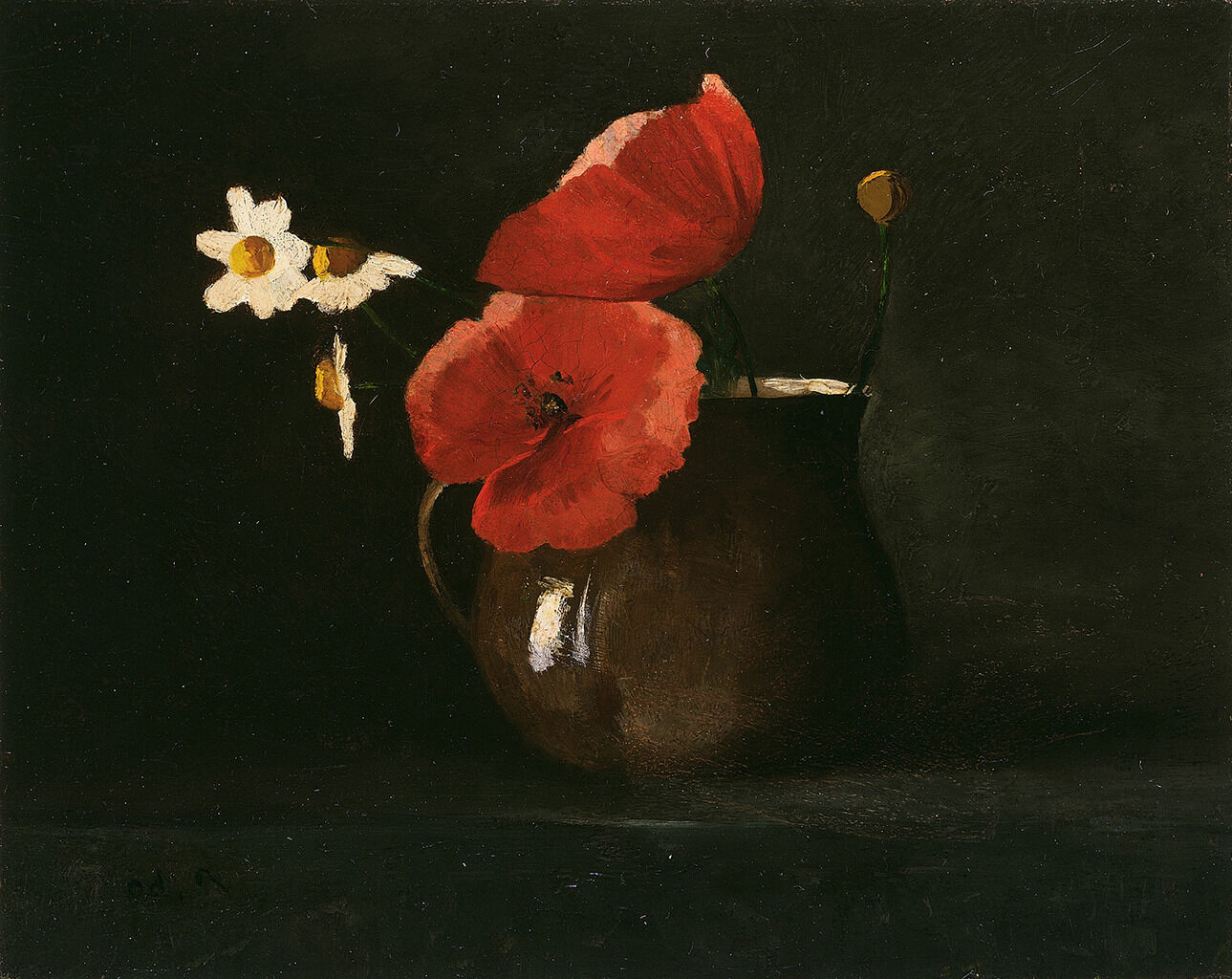
While many of his Impressionist colleagues were exploring the fleeting effects of light and atmosphere in the 1870s and 1880s in luminous easel paintings, Redon produced hundreds of enigmatic charcoal drawings and lithographs—works the artist referred to as his noirs.1On Redon’s noirs, see, among many others, Barbara Larson, The Dark Side of Nature: Science, Society, and the Fantastic in the Work of Odilon Redon (University Park: Pennsylvania State University Press, 2005). For a technical study of the charcoal noirs, see Harriet K. Stratis, “A Technical Investigation of Odilon Redon’s Pastels and Noirs,” The Book and Paper Group Annual 14 (1995): 87–103. In these decades, Redon maintained that black was uniquely associated with the internal realms of thoughts and dreams, whereas color was external and connected to material reality.2See his short essay titled “Réflexions sur une exposition des impressionnistes,” April 10, 1880, in Odilon Redon, A soi-même, journal (1867–1915): Notes sur la vie, l’art et les artistes (Paris: H. Floury, 1922), 155–56. He wrote about his turn to pastel as giving a degree of “extériorité” to his dreams in Odilon Redon, “Confidences d’artiste,” L’Art moderne, no. 34 (August 25, 1894): 270. Later, he wrote about the color black: “Il est agent de l’esprit bien plus que la plus belle couleur de la palette ou du prisme” (It is the agent of the spirit much more than the splendid color of the palette or of the prism). See Odilon Redon, “De soi-même: quelques notes de Odilon Redon,” in Odilon Redon, by André Mellerio (Paris: Secrétariat, 1913), 67. Translated in Odilon Redon, To Myself: Notes on Life, Art, and Artists, trans. Mira Jacob and Jeanne L. Wasserman (New York: George Braziller, 1986), 103. In his noirs—including the Nelson-Atkins charcoal and chalk drawing Salomé with the Head of Saint John the Baptist, ca. 1880–85 (81-30/67)—Redon manipulated his black materials to create tonally complex and richly layered surfaces that contribute to his often mysterious motifs, drawn from such diverse sources as mythology, the Bible, contemporary literature, evolutionary science, and his own subjective fantasies.3It has been suggested that this work was the charcoal drawing titled “Salomé” that Redon included in the eighth Impressionist exhibition in 1886. See Douglas W. Druick et al., Odilon Redon: Prince of Dreams, 1840–1916, exh. cat. (Chicago: Art Institute of Chicago, 1994), 453. By moving beyond the descriptive tendencies of naturalism and Impressionism, Redon came to conceive of his art as “suggestive art” and believed that through formal ambiguities rendered in black he could engage the imaginative aspects of his viewers’ powers of perception.4Redon, “Confidences d’artiste,” 269.
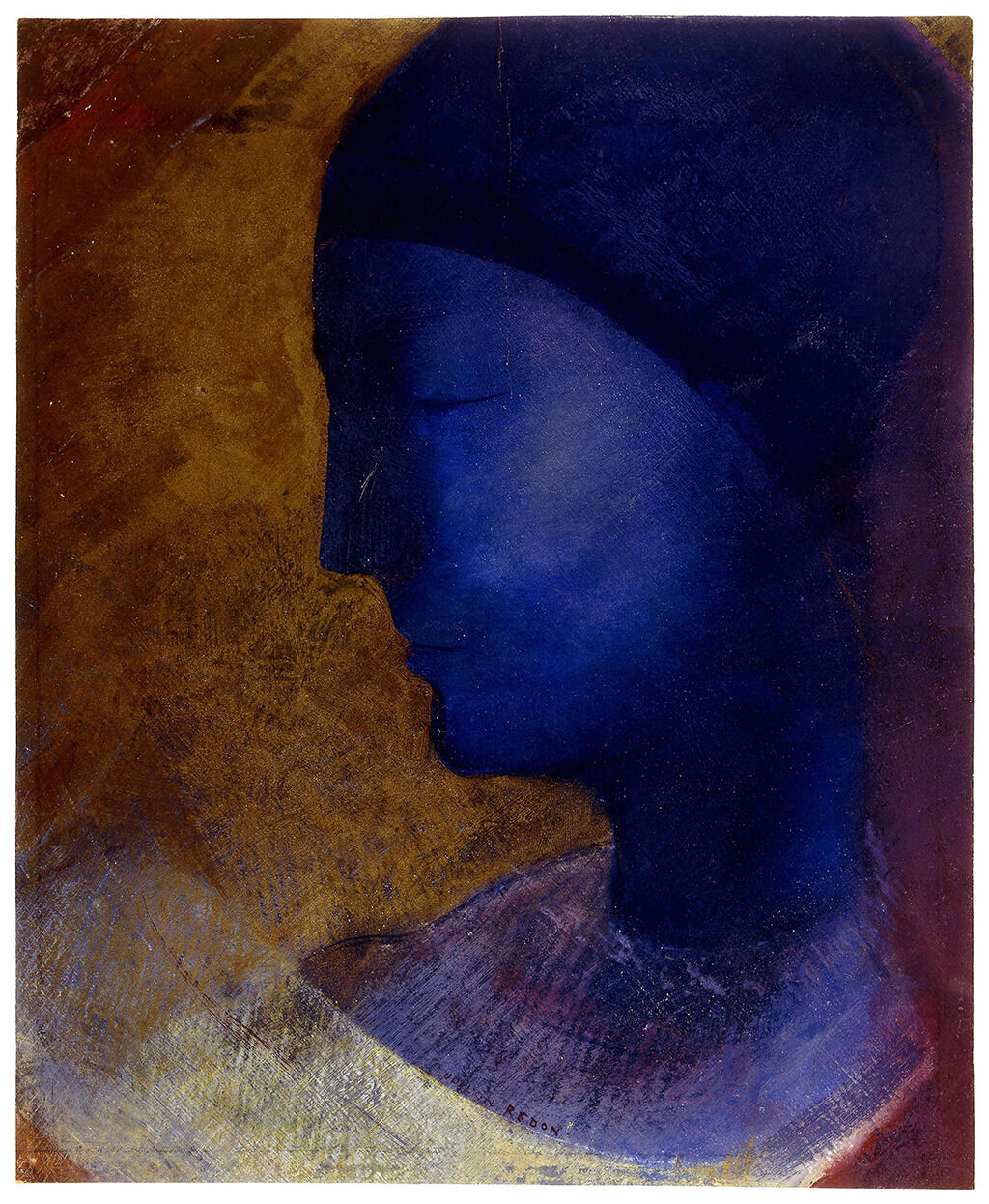
In addition, while some art historians have attributed a further biographical rationale to Redon’s shift toward color, arguing that personal circumstances effectively brightened his palette,8Druick and Zegers suggest that, in part, Redon’s embrace of color was due to his“increased success, marriage, and fatherhood,” causing him to ultimately become more “inclusive.” Douglas W. Druick and Peter Kort Zegers, “In the Public Eye,” in Druick et al., Odilon Redon, 173. others have acknowledged how changing market demands likely instigated this pivot in his artistic practice.9Redon wrote to Andries Bonger in January 1900 about his increased output of pastels, noting “people want them, and they take them from me as soon as they are made.” Quoted in Kevin Sharp, “Redon and the Marketplace after 1900,” in Druick et al., Odilon Redon, 258. During the 1890s, Redon developed a growing circle of devoted collectors and patrons, many of whom came from the upper echelons of society.10On Redon’s patrons and collectors, see, among others, Gloria Groom, “The Late Work,” in Druick et al., Odilon Redon, 305–52. With them came not only commissions, in the form of portraits and decorative ensembles, but also a new focus on floral still lifes, a desirable genre for which the demand was high. In the hundreds of still lifes he created in oil and pastel after 1890, Redon featured garden flowers cut and arranged in vases selected from a vast collection (very likely in collaboration with his wife, Camille). A posthumous inventory produced by scholar Agnès Lacau St. Guily details more than eighty vases depicted by Redon; the particular two-handled vessel in the Nelson-Atkins painting appears in at least two other known pictures.11See the “Inventaire des formes des vases” and catalogue nos. 1440–42 in Alec Wildenstein and Agnès Lacau St. Guily, Odilon Redon: Catalogue raisonné de l’œuvre peint et dessiné, vol. 3, Fleurs et paysages (Paris: Wildenstein Institute, 1996), 8–10, 62, 68–69. The other two paintings remain in private collections.
Redon’s rapid production of floral still lifes, along with his tendency to assign vague titles and forgo dating his canvases, makes it challenging to establish firm dates and provenances for works like The Green Vase. Thomas Gibson Fine Art provided the present title (Le vase vert), a date of circa 1900, and a provenance of “Ancienne Collection, Pompidor, France, thence by descent” when they sold the painting to Marion and Henry Bloch in 1995.12Thomas H. Gibson to Henry Bloch, July 19, 1995, NAMA curatorial files. Further correspondence with Gibson suggested that “Pompidor” (possibly a Monsieur de Pompidour) lived near Montpellier and received collecting advice from Gustave Fayet (1865–1925), a vintner, artist, and important collector of Redon, Gauguin, Paul Cezanne (1839–1906), and Vincent van Gogh (1853–90).13Aphrodite O’Sullivan, assistant to Thomas H. Gibson, to Nicole Myers, April 27, 2015, NAMA curatorial files. Could this be the same Dr. Paul Pompidor who lived in Narbonne and was acquiring paintings by Vincent van Gogh around 1901?14This is purely speculative. See the provenance for no. F 663 and F 664 in J.-B. de la Faille, The Works of Vincent van Gogh: His Paintings and Drawings, rev. ed. (Amsterdam: Meulenhoff International, 1970), 261–62, 637. See also the provenance for Champs près des Alpilles (F 663) when it sold at Christie’s, May 11, 2022, https://www.christies.com/lot/lot-6368787; and Douglas Cooper, The Courtauld Collection: A Catalogue and Introduction (London: Athlone Press, 1954), 69n1. Efforts on behalf of Nelson-Atkins researchers and staff to clarify this ownership history have not as yet resulted in further clarity. Complicating matters further, there is neither a painting titled Le vase vert nor any reference to “Pompidor” in Redon’s account books, which detail his sales.15Odilon Redon, “Livre de raison,” published as a CD-ROM in Rodolphe Rapetti, Odilon Redon: Prince du Rêve, 1840–1916, exh. cat. (Paris: Réunion des musées nationaux, 2011).
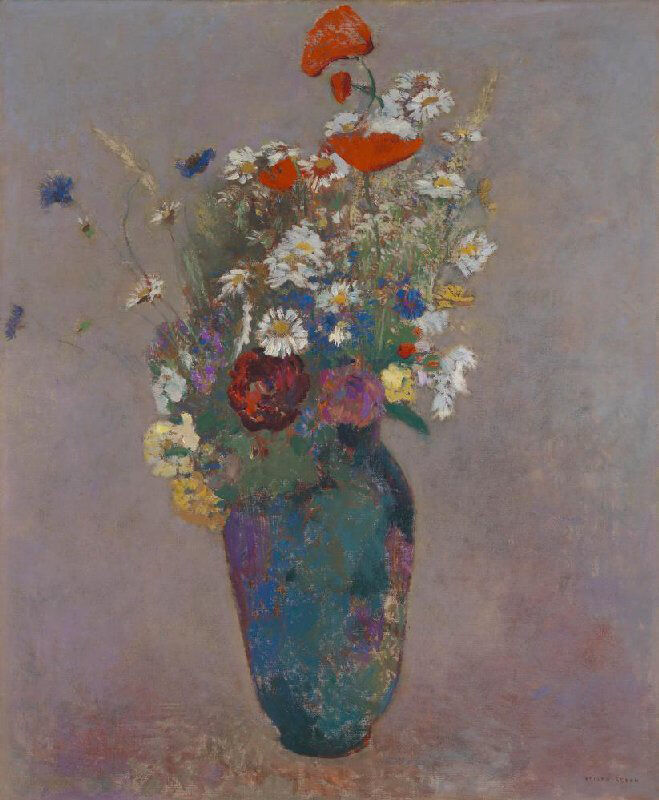
In response to the works on display at Durand-Ruel that March, critics commended Redon’s ability as a colorist, referencing the “seductions of [his] palette” and the synesthetic “divine joy of his music of colors.”19For “les séductions d’une palette”, see Roger Marx, “Petites expositions: Exposition Odilon Redon,“ La Chronique des arts et de la curiosité (March 21, 1903): 95. For “la joie divine de ses musiques de couleurs”, see Charles Morice, “Revue du mois: Pastels et peintures de M. Odilon Redon,” Mercure de France 4 (April 1903): 239. All translations are by Kirsten Marples, unless otherwise noted. While some struggled to reconcile his apparent interest in nature with his tendency toward symbolism,20Renée-Marc Ferry, “Beaux-Arts: Les petites expositions.—Chez Durand-Ruel: M. Odilon-Redon,” La Liberté, March 21, 1903. “Les peintures, qui représentent pour la plupart des fleurs ou des fruits et n’ont rien de symbolique . . .” (The paintings, which represent for the most part flowers or fruits and contain nothing symbolic . . .). others noticed how his still lifes and portraits seemed to exist in a “strange mystery in his vision of the beyond.”21G. M., Le Journal des Artistes, March 11, 1903. “. . . un mystère étrange dans sa vision de l’au-delà.” This tension between reality and dream, naturalistic description and symbolist suggestion, characterizes many of Redon’s floral works—including The Green Vase, with both its evidence of careful observation and its spatial ambiguity. Having visited the Durand-Ruel exhibition, Maurice Denis lauded Redon in a review, pinpointing a continuity between Redon’s symbolist noirs and his recent color work: “By what miracle, these poppies, these wildflowers—of sap so intense—retain the same strange charm that captivated us in the nocturnal and romantic [charcoals and] lithographs of times past?”22Maurice Denis, “Œuvres récentes d’Odilon Redon,” L’Occident (April 1903): 256. “Par quel miracle ces coquelicots, ces fleurs des champs, de sève si intense conservent-ils tout de même le charme étrange qui nous passionnait dans les nocturnes et romantiques lithographies d’autrefois?” Indeed, despite its adherence to nature’s forms, The Green Vase possesses a distinctive, mysterious appeal in its nuanced blurring of the boundaries between reality and dream.
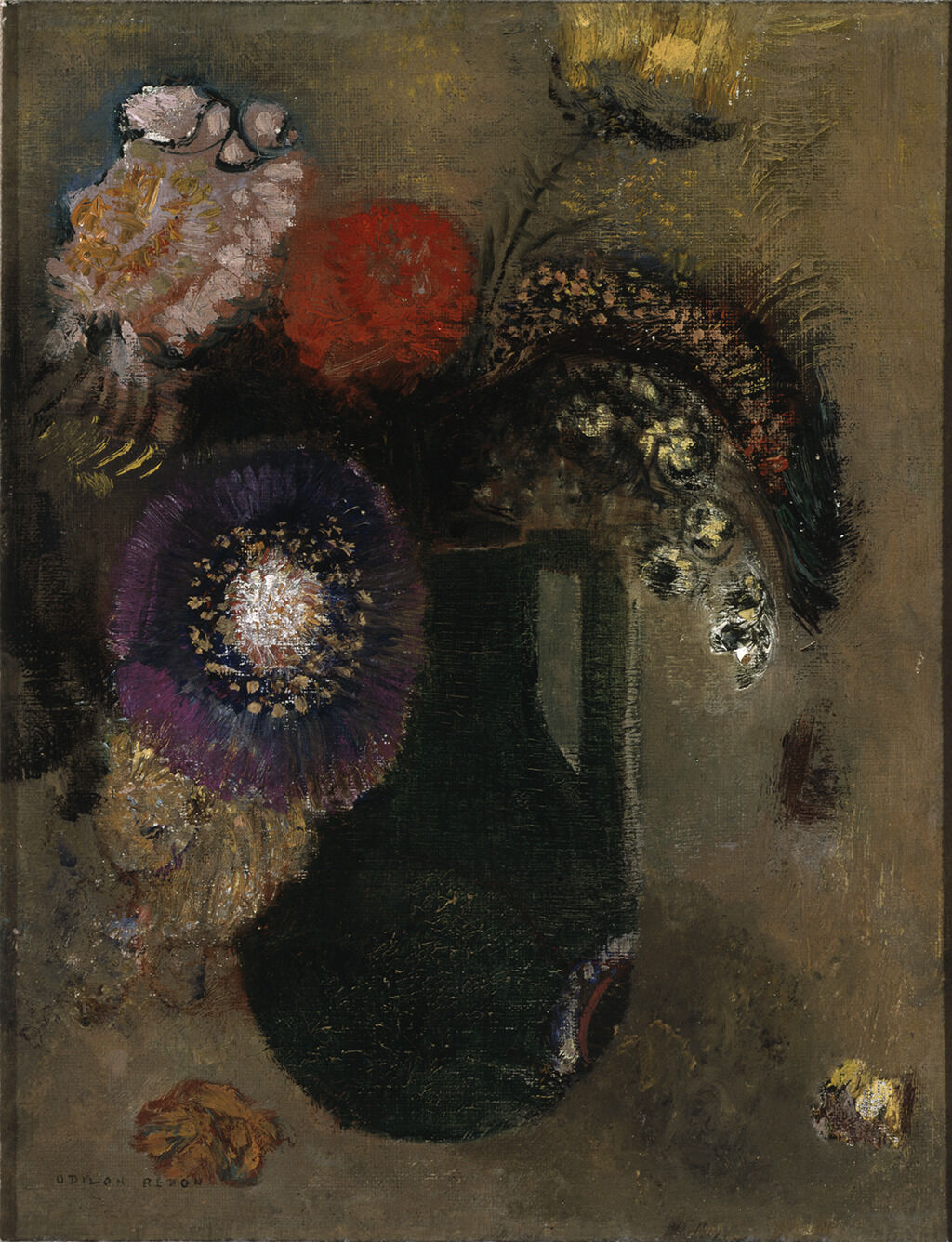
Redon preferred a matte surface for his paintings, to achieve an effect similar to that of pastel or charcoal.26Harriet K. Stratis, “Beneath the Surface: Redon’s Methods and Materials,” in Druick et al., Odilon Redon, 376–77. Like many of his avant-garde contemporaries, including Gauguin, Redon avoided varnish.27Maryanne Stevens, “Redon’s Artistic and Critical Position,” in Druick et al., Odilon Redon, 287. Doing so urged viewers to notice his mark-making and materials, and to pay attention to the “action of those secret traces.”28Redon, “De soi-même,” 70. Translated in Redon, To Myself, 107. “. . . l’action de ces linéaments secrets . . .” Redon’s relatively economical application of paint is evident in the background of The Green Vase; despite a thin layer of varnish added at some point after its completion, the painting retains Redon’s desired tactile elements.29See examination report by Scott Heffley, May 6, 2015, NAMA curatorial files. He notes that the painting “almost looks unvarnished.” His varied brushwork is still visible: dry, wispy strokes in the plumes of grass; swift dabs forming the purple lilac-like clusters; reds painted wet-into-wetwet-into-wet: An oil painting technique which involves blending of colors on the picture surface. in the poppies; and areas of strategic buildup in the yellow roses. Through this intentional materiality, Redon sought not just “color that is seen,” but rather “the supreme and so pure beauty of color that is sensed.”30Redon, A soi-même, 169, from an essay on Delacroix, dated 1878: “Tâchons au moins de donner à la couleur vue la beauté suprême et si pure de la couleur sentie; tout l’art moderne est là” (Let us at least try to give to color that is seen, the supreme and so pure beauty of color that is sensed: all of modern art is there). Such color sought to invoke all the senses, not just sight.
Redon’s approach to color secured his artistic legacy among key twentieth-century artists, including Henri Matisse (1869–1954), Marcel Duchamp (1887–1968), and André Masson (1896–1987). Matisse notably collected pastels by Redon,31See Marie-Pierre Salé, “Redon et ses collectionneurs,” in Rapetti, Odilon Redon, 51; Raphaël Bouvier, “Odilon Redon and the Art of the Twentieth Century: An Introduction to the Exhibition” in Bouvier, ed., Odilon Redon, 16. and Duchamp claimed that Redon’s sense of ambiguity in his color work was his own “point of departure.”32Marcel Duchamp to Magda and Walter Pach, June 24, 1927, quoted in Bouvier, “Odilon Redon and the Art of the Twentieth Century,” 20. For Masson, Redon productively drew from nature’s mystery, especially in his floral still lifes, using his “botanist’s arsenal”: “Even his most reassuring bouquets suddenly will tear through their apparent repose, become astral vertigo, spurt and decline—a mystery.”33André Masson, “Redon: Mystic with a Method,” Art News 55, no. 9 (January 1957): 61.
Notes
-
On Redon’s noirs, see, among many others, Barbara Larson, The Dark Side of Nature: Science, Society, and the Fantastic in the Work of Odilon Redon (University Park: Pennsylvania State University Press, 2005). For a technical study of the charcoal noirs, see Harriet K. Stratis, “A Technical Investigation of Odilon Redon’s Pastels and Noirs,” The Book and Paper Group Annual 14 (1995): 87–103.
-
See his short essay titled “Réflexions sur une exposition des impressionnistes,” April 10, 1880, in Odilon Redon, A soi-même, journal (1867–1915): Notes sur la vie, l’art et les artistes (Paris: H. Floury, 1922), 155–56. He wrote about his turn to pastel as giving a degree of “extériorité” to his dreams in Odilon Redon, “Confidences d’artiste,” L’Art moderne, no. 34 (August 25, 1894): 270. Later, he wrote about the color black: “Il est agent de l’esprit bien plus que la plus belle couleur de la palette ou du prisme” (It is the agent of the spirit much more than the splendid color of the palette or of the prism). See Odilon Redon, “De soi-même: quelques notes de Odilon Redon,” in Odilon Redon, by André Mellerio (Paris: Secrétariat, 1913), 67. Translated in Odilon Redon, To Myself: Notes on Life, Art, and Artists, trans. Mira Jacob and Jeanne L. Wasserman (New York: George Braziller, 1986), 103.
-
It has been suggested that this work was the charcoal drawing titled “Salomé” that Redon included in the eighth Impressionist exhibition in 1886. See Douglas W. Druick et al., Odilon Redon: Prince of Dreams, 1840–1916, exh. cat. (Chicago: Art Institute of Chicago, 1994), 453.
-
Redon, “Confidences d’artiste,” 269.
-
Margret Stuffmann, “Odilon Redon: Paths to Color,” in Odilon Redon, ed. Raphaël Bouvier, exh. cat. (Basel: Fondation Beyeler, 2014), 69. Redon likely met Gauguin around 1886, the year of the eighth and final Impressionist exhibition, to which they both contributed. Over the next few years, they benefited from a reciprocal exchange of letters, art, and aesthetic ideas.
-
See, for example: Albert Aurier, “Le Symbolisme en peinture: Paul Gauguin,” Mercure de France, no. 15 (March 1891): 155–65.
-
The mutual influence between Redon and the Nabis is discussed in Ursula Perucchi-Petri, “‘Jeunes Peintres, Mes Amis’: Odilon Redon and the Nabis,” in Odilon Redon: As in a Dream, ed. Margret Stuffmann and Max Hollein, exh. cat. (Ostfildern, Germany: Hatje Cantz, 2007), 103–11.
-
Druick and Zegers suggest that, in part, Redon’s embrace of color was due to his “increased success, marriage, and fatherhood,” causing him to ultimately become more “inclusive.” Douglas W. Druick and Peter Kort Zegers, “In the Public Eye,” in Druick et al., Odilon Redon, 173.
-
Redon wrote to Andries Bonger in January 1900 about his increased output of pastels, noting “people want them, and they take them from me as soon as they are made.” Quoted in Kevin Sharp, “Redon and the Marketplace after 1900,” in Druick et al., Odilon Redon, 258.
-
On Redon’s patrons and collectors, see, among others, Gloria Groom, “The Late Work,” in Druick et al., Odilon Redon, 305–52.
-
See the “Inventaire des formes des vases” and catalogue nos. 1440–42 in Alec Wildenstein and Agnès Lacau St. Guily, Odilon Redon: Catalogue raisonné de l’œuvre peint et dessiné, vol. 3, Fleurs et paysages (Paris: Wildenstein Institute, 1996), 8–10, 62, 68–69. The other two paintings remain in private collections.
-
Thomas H. Gibson to Henry Bloch, July 19, 1995, NAMA curatorial files.
-
Aphrodite O’Sullivan, assistant to Thomas H. Gibson, to Nicole Myers, April 27, 2015, NAMA curatorial files.
-
This is purely speculative. See the provenance for no. F 663 and F 664 in J.-B. de la Faille, The Works of Vincent van Gogh: His Paintings and Drawings, rev. ed. (Amsterdam: Meulenhoff International, 1970), 261–62, 637. See also the provenance for Champs près des Alpilles (F 663) when it sold at Christie’s, May 11, 2022, https://www.christies.com/lot/lot-6368787; and Douglas Cooper, The Courtauld Collection: A Catalogue and Introduction (London: Athlone Press, 1954), 69n1.
-
Odilon Redon, “Livre de raison,” published as a CD-ROM in Rodolphe Rapetti, Odilon Redon: Prince du Rêve, 1840–1916, exh. cat. (Paris: Réunion des musées nationaux, 2011).
-
Pastels et peintures d’Odilon Redon, exh. cat. (Paris: Galeries Durand-Ruel, 1903), unpaginated. See also Sophie Pietri to Brigid Boyle, January 13, 2021, NAMA curatorial files.
-
On this painting, see catalogue no. 28 in Fleur Roos Rosa de Carvalho, Odilon Redon and Andries Bonger: 36 Works from the Van Gogh Museum Collection (Amsterdam: Van Gogh Museum, 2022), 136–43, online edition.
-
Rosa de Carvalho, Odilon Redon and Andries Bonger, 136–37. Redon listed this painting in his account book in June 1901 as “Fleurs, dans un vase, peinture (toile 20). Vase de Marie Botkine.” See Redon, “Livre de raison.”
-
For “les séductions d’une palette”, see Roger Marx, “Petites expositions: Exposition Odilon Redon,” La Chronique des arts et de la curiosité (March 21, 1903): 95. For “la joie divine de ses musiques de couleurs”, see Charles Morice, “Revue du mois: Pastels et peintures de M. Odilon Redon,” Mercure de France 4 (April 1903): 239. All translations are by Kirsten Marples, unless otherwise noted.
-
Renée-Marc Ferry, “Beaux-Arts: Les petites expositions.—Chez Durand-Ruel: M. Odilon-Redon,” La Liberté, March 21, 1903. “Les peintures, qui représentent pour la plupart des fleurs ou des fruits et n’ont rien de symbolique . . .” (The paintings, which represent for the most part flowers or fruits and contain nothing symbolic . . .).
-
G. M., Le Journal des Artistes, March 11, 1903. “. . . un mystère étrange dans sa vision de l’au-delà.”
-
Maurice Denis, “Œuvres récentes d’Odilon Redon,” L’Occident (April 1903): 256. “Par quel miracle ces coquelicots, ces fleurs des champs, de sève si intense conservent-ils tout de même le charme étrange qui nous passionnait dans les nocturnes et romantiques lithographies d’autrefois?”
-
Redon, “Confidences d’artiste,” 269. “J’ai toujours éprouvé la nécessité de copier la nature en des objets menus, particuliers, fortuits ou accidentels. C’est seulement après un effort de volonté pour représenter minutieusement un brin d’herbe, une pierre, une branche . . . que je suis pris comme d’un tourment de créer de l’imaginaire” (I have always felt the need to copy nature in its small, particular, fortuitous, or accidental objects. It is only after a determined effort to meticulously represent a blade of grass, a stone, a branch, . . . that I am taken by a torment to create the imaginary).
-
Redon, A soi-même, 19. “Il cherchait . . . sur les confins du monde imperceptible, cette vie intermédiaire entre l’animalité et la plante, cette fleur ou cet être.” Translated in Redon, To Myself, 14. On Clavaud and Redon, see Barbara Larson, “From Botany to Belief: Odilon Redon and Armand Clavaud,” in Stuffmann and Hollein, eds., Odilon Redon, 95–101.
-
Redon, A soi-même, 115. “Fleurs venues au confluent de deux rivages, celui de la représentation, celui du souvenir” (Flowers at the confluence of two river banks, that of representation and that of memory). Translated in Redon, To Myself, 99.
-
Harriet K. Stratis, “Beneath the Surface: Redon’s Methods and Materials,” in Druick et al., Odilon Redon, 376–77.
-
Maryanne Stevens, “Redon’s Artistic and Critical Position,” in Druick et al., Odilon Redon, 287.
-
Redon, “De soi-même,” 70. Translated in Redon, To Myself, 107. “. . . l’action de ces linéaments secrets . . .”
-
See examination report by Scott Heffley, May 6, 2015, NAMA curatorial files. He notes that the painting “almost looks unvarnished.”
-
Redon, A soi-même, 169, from an essay on Delacroix, dated 1878: “Tâchons au moins de donner à la couleur vue la beauté suprême et si pure de la couleur sentie; tout l’art moderne est là” (Let us at least try to give to color that is seen, the supreme and so pure beauty of color that is sensed: all of modern art is there).
-
See Marie-Pierre Salé, “Redon et ses collectionneurs,” in Rapetti, Odilon Redon, 51; Raphaël Bouvier, “Odilon Redon and the Art of the Twentieth Century: An Introduction to the Exhibition” in Bouvier, ed., Odilon Redon, 16.
-
Marcel Duchamp to Magda and Walter Pach, June 24, 1927, quoted in Bouvier, “Odilon Redon and the Art of the Twentieth Century,” 20.
-
André Masson, “Redon: Mystic with a Method,” Art News 55, no. 9 (January 1957): 61.
Technical Entry
Citation
Chicago:
Diana M. Jaskierny, “Odilon Redon, The Green Vase, ca. 1900,” technical entry in French Paintings and Pastels, 1600–1945: The Collections of The Nelson-Atkins Museum of Art, ed. Aimee Marcereau DeGalan (Kansas City: The Nelson-Atkins Museum of Art, 2022), https://doi.org/10.37764/78973.5.720.2088.
MLA:
Jaskierny, Diana M. “Odilon Redon, The Green Vase, ca. 1900,” technical entry. French Paintings and Pastels, 1600–1945: The Collections of The Nelson-Atkins Museum of Art, edited by Aimee Marcereau DeGalan, Nelson-Atkins Museum of Art, 2022. doi: 10.37764/78973.5.720.2088.
The Green Vase was executed on a finely woven plain-weaveplain weave: A basic textile weave in which one weft thread alternates over and under the warp threads. Often this structure consists of one thread in each direction, but threads can be doubled (basket weave) or tripled to create more complex plain weave. Plain weave is sometimes called tabby weave. canvas, affixed to a five-member stretcherstretcher: A wooden structure to which the painting’s canvas is attached. Unlike strainers, stretchers can be expanded slightly at the joints to improve canvas tension and avoid sagging due to humidity changes or aging..1The stretcher is non-original, and a second set of visible tack holes on the stretcher indicates that it was previously used. The dimensions of the canvas were altered at an unknown date, reducing the original width.2In its current state, the painting is close in size to a no. 20 paysage standard-format canvas (73 x 56.7 centimeters), rotated ninety degrees. The vertical dimension has retained its original size of 73 centimeters, consistent with all no. 20 standard-formats. The original left turnover edgeturnover edge: The point at which the canvas begins to wrap around the stretcher, at the junction between the picture plane and tacking margin. See also foldover edge. is retained on the tacking margin, narrowing the image on this side by 1 centimeter. On the right side, 2 centimeters of the original picture planepicture plane: The two-dimensional surface where the artist applies paint. are present on the current tacking margintacking margins: The outer edges of canvas that wrap around and are attached to the stretcher or strainer with tacks or staples. See also tacking edge. edge, and there is no sign of the original turnover edge. (Fig. 5). If one assumes that little to no original paint was cropped from the right side of the canvas, based on the central placement of the still-life, the original dimensions appear to correspond to the LeFranc & Cie no. 20 portrait standard-format supportstandard-format supports: Commercially prepared supports available through art suppliers, which gained popularity in the nineteenth century during the industrialization of art materials. Available in three formats figure (portrait), paysage (landscape), and marine (marine), these were numbered 1 through 120 to indicate their size. For each numbered size, marine and paysage had two options available: a larger format (haute) and smaller (basse) format. (73 x 59.6 centimeters).3The portrait format is the widest of the standard-formats, and therefore the original picture plane was likely not greatly cropped. David Bomford, Jo Kirby, John Leighton, and Ashok Roy, Art in the Making: Impressionism (London: Yale University Press, 1991), 45. On the reverse of the canvas, there is a black stamp marking “20,” further indicating the originally intended vertical orientation (Fig. 6).4Although the stretcher crossbar does have a stamp for the supplier Durand, because this stretcher is not original to The Green Vase, it is unlikely that this stamp relates to this painting.
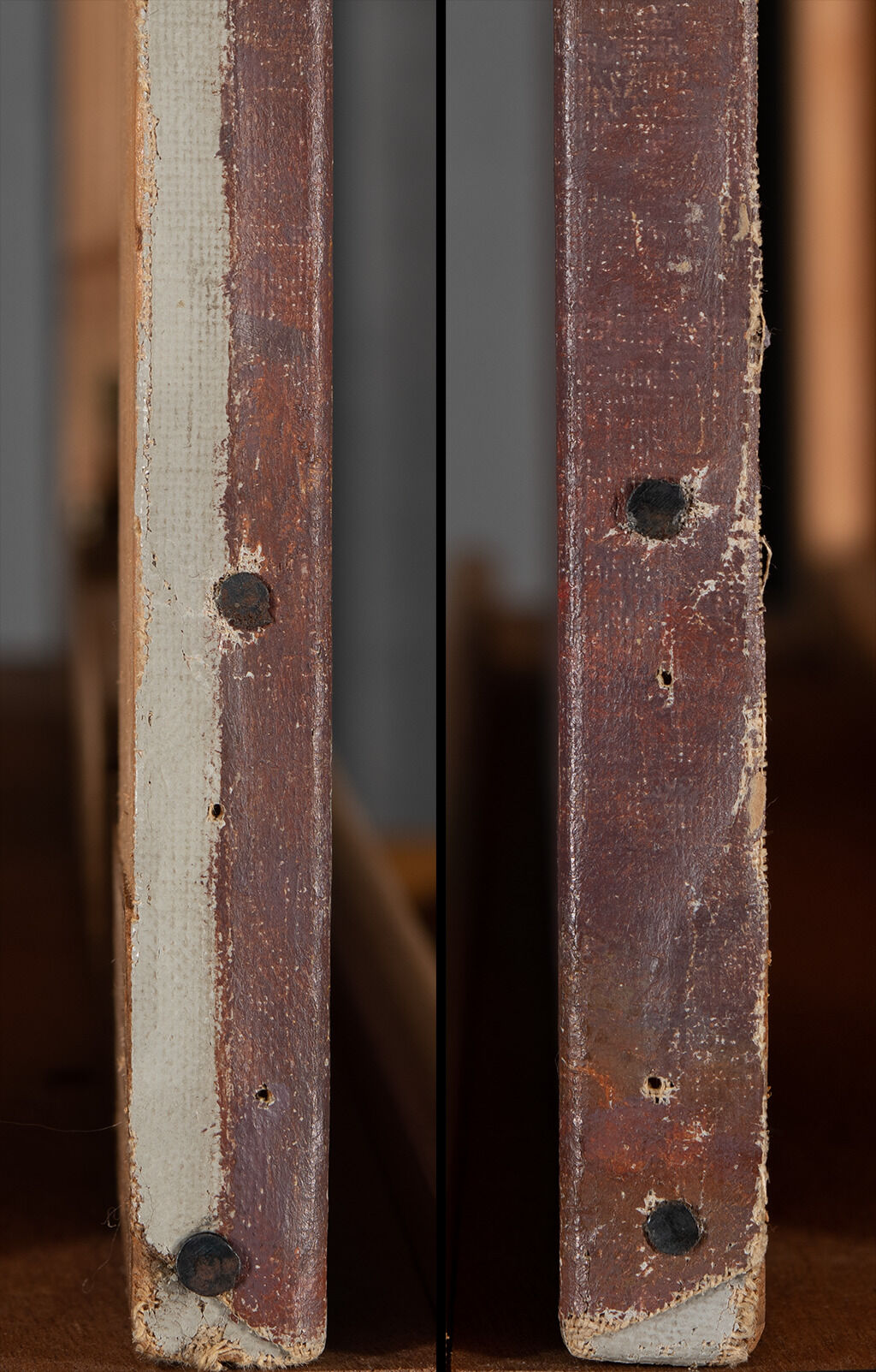 Fig. 5. Detail of the left and right tacking margins, displaying the original picture plane past the turnover edges, The Green Vase (ca. 1900)
Fig. 5. Detail of the left and right tacking margins, displaying the original picture plane past the turnover edges, The Green Vase (ca. 1900)
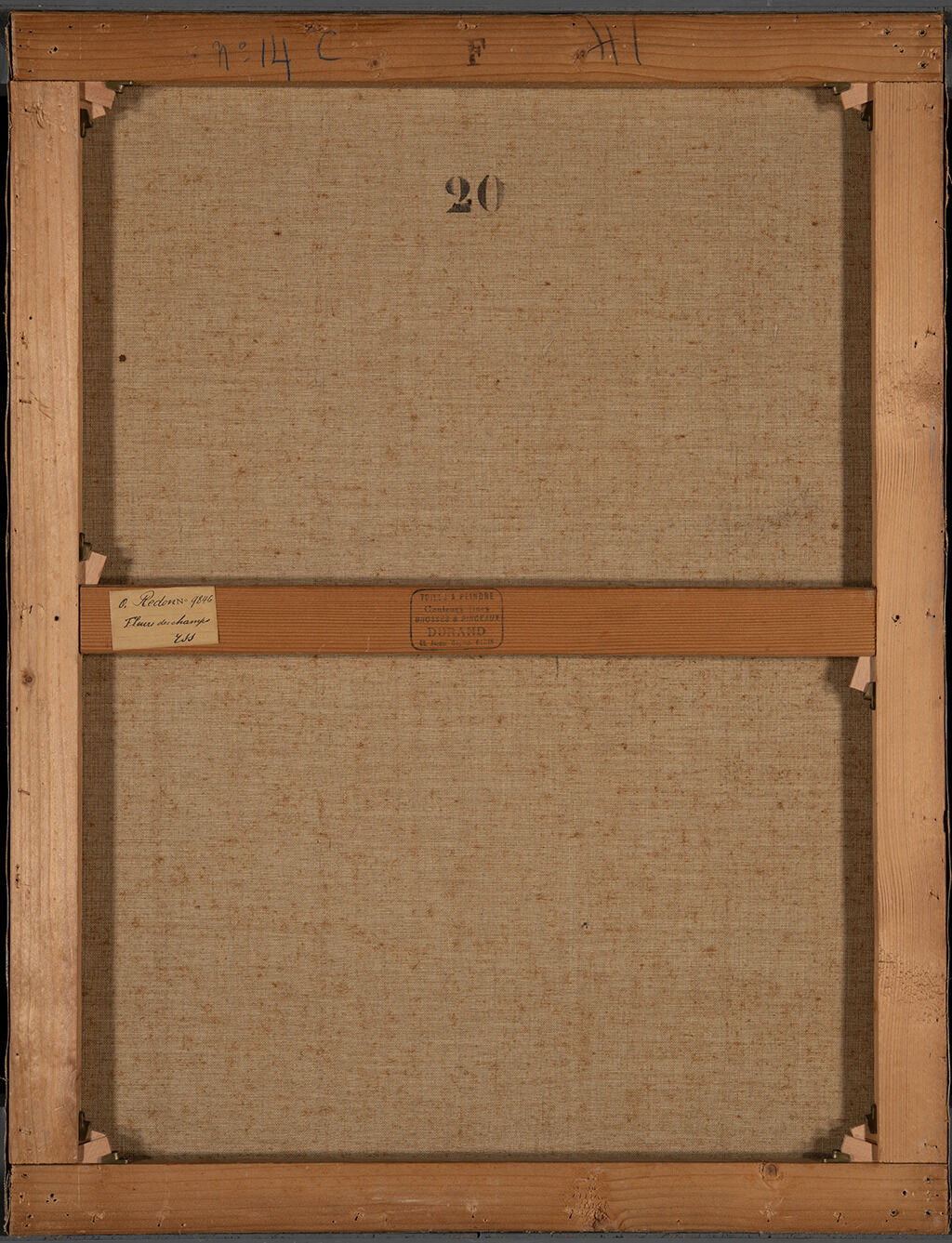 Fig. 6. Canvas reverse, The Green Vase (ca. 1900)
Fig. 6. Canvas reverse, The Green Vase (ca. 1900)
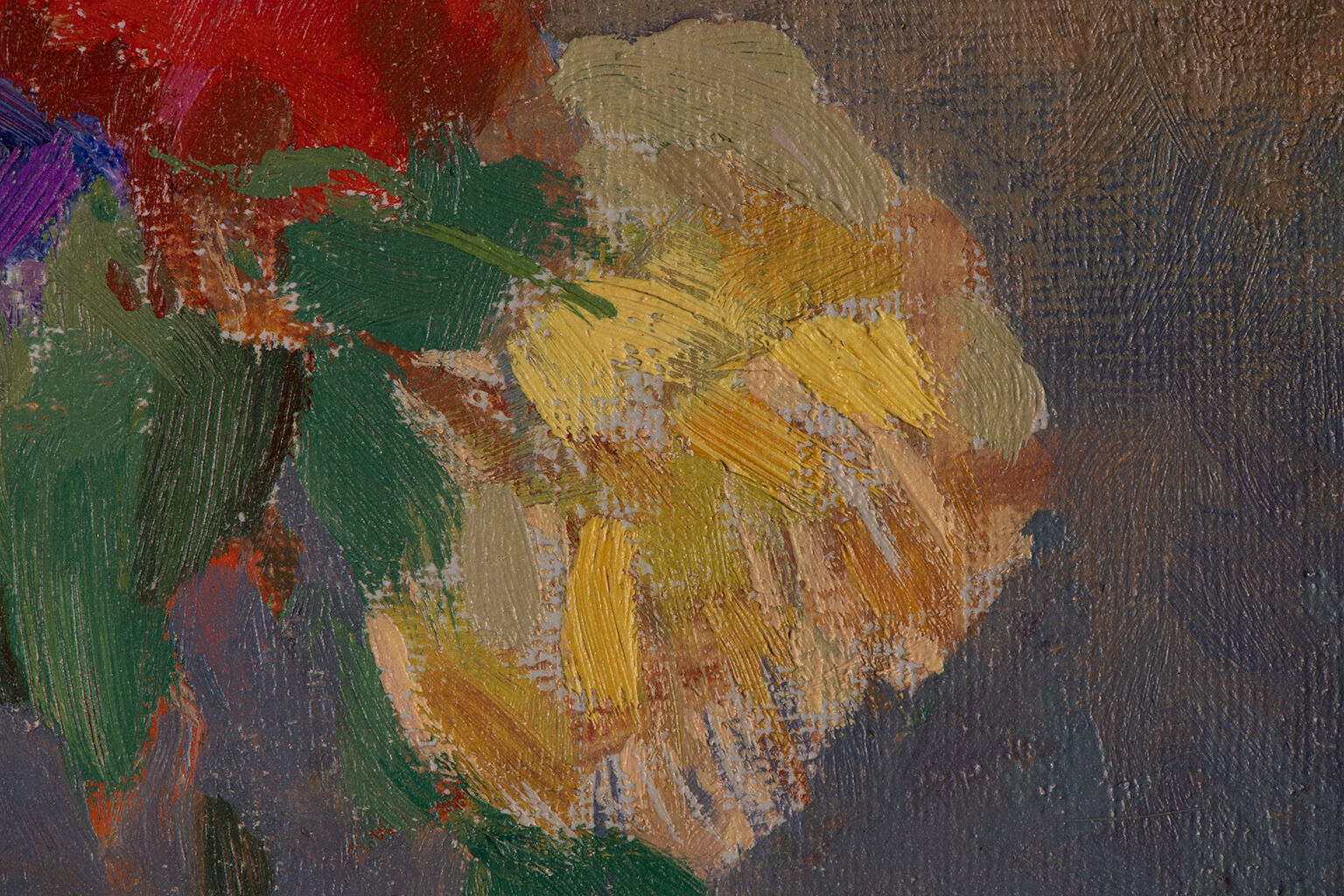 Fig. 7. Detail of exposed ground within the flowers, The Green Vase (ca. 1900)
Fig. 7. Detail of exposed ground within the flowers, The Green Vase (ca. 1900)
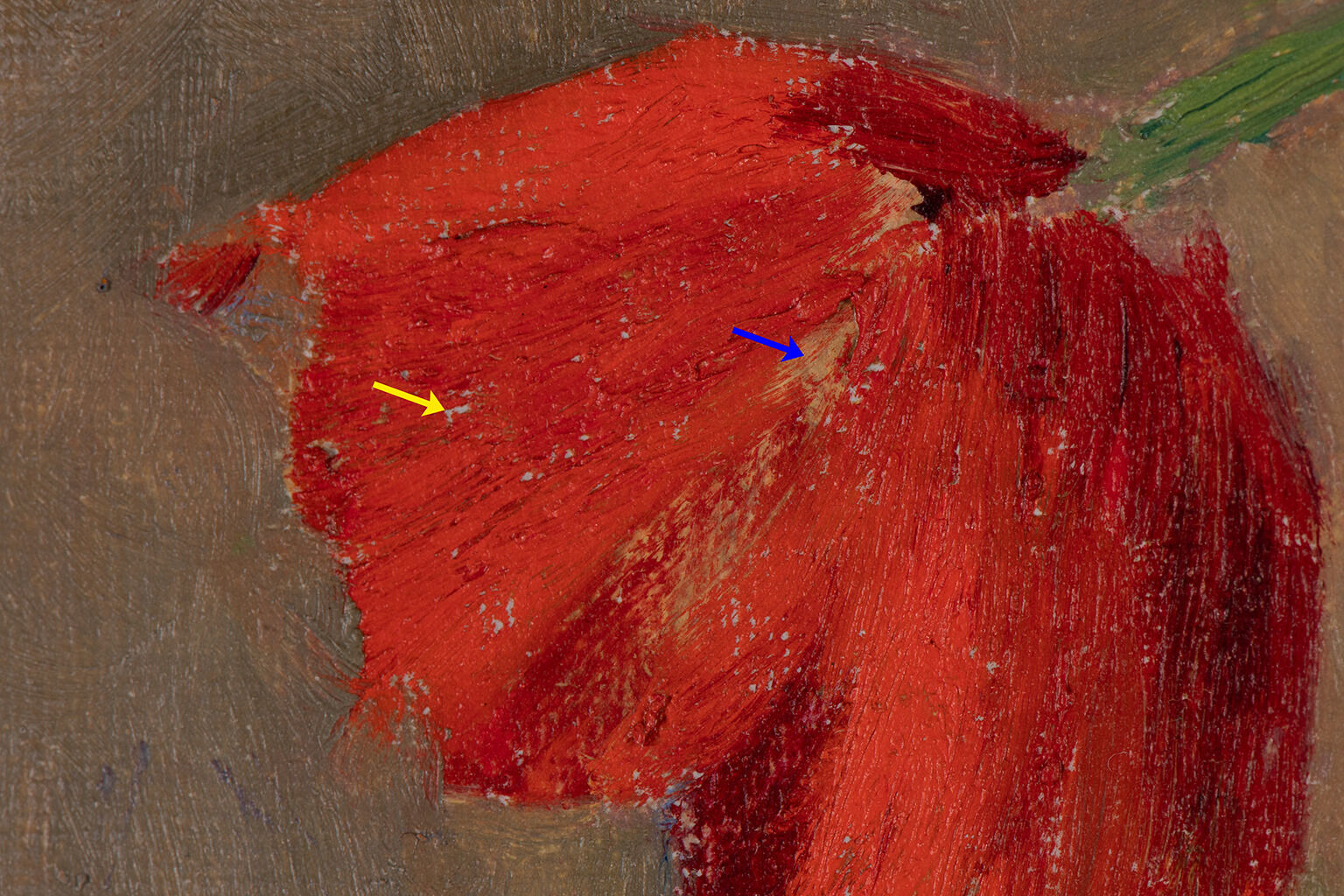 Fig. 8. Detail of underpainting extending beneath a flower (blue arrow) in comparison to the exposed ground in the same flower (yellow arrow), The Green Vase (ca. 1900)
Fig. 8. Detail of underpainting extending beneath a flower (blue arrow) in comparison to the exposed ground in the same flower (yellow arrow), The Green Vase (ca. 1900)
Although it appears there is no overall underdrawing, Redon used these same warm tones to loosely define the flowers, and more specifically, to place the vase. Peeking between the paint of the background and the handles of the vase, the painted sketch remains visible (Fig. 9). In parts of the bouquet, it appears that Redon also used these tones to lay in the general placement of the flowers, such as in the blooms to the right, where a number of loosely painted strokes of translucent warm red were applied before the purple petals were added (Fig. 10). As with the background’s underpainting, it is unclear how comprehensive this painted sketch is, as the overlapping paint strokes may conceal much of the preliminary layers of the bouquet.
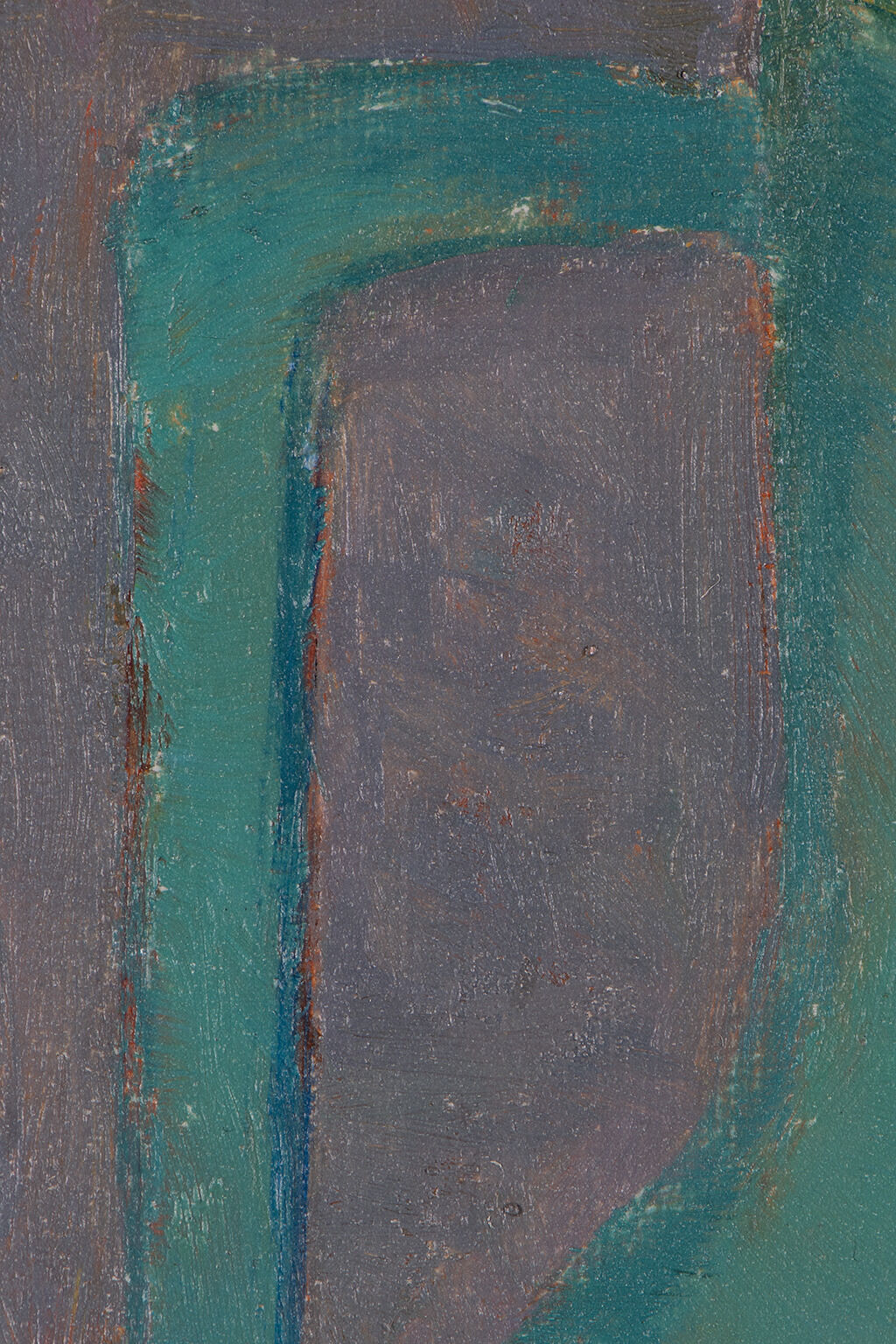 Fig. 9. Detail of the reddish-orange underpainting of the vase, The Green Vase (ca. 1900)
Fig. 9. Detail of the reddish-orange underpainting of the vase, The Green Vase (ca. 1900)
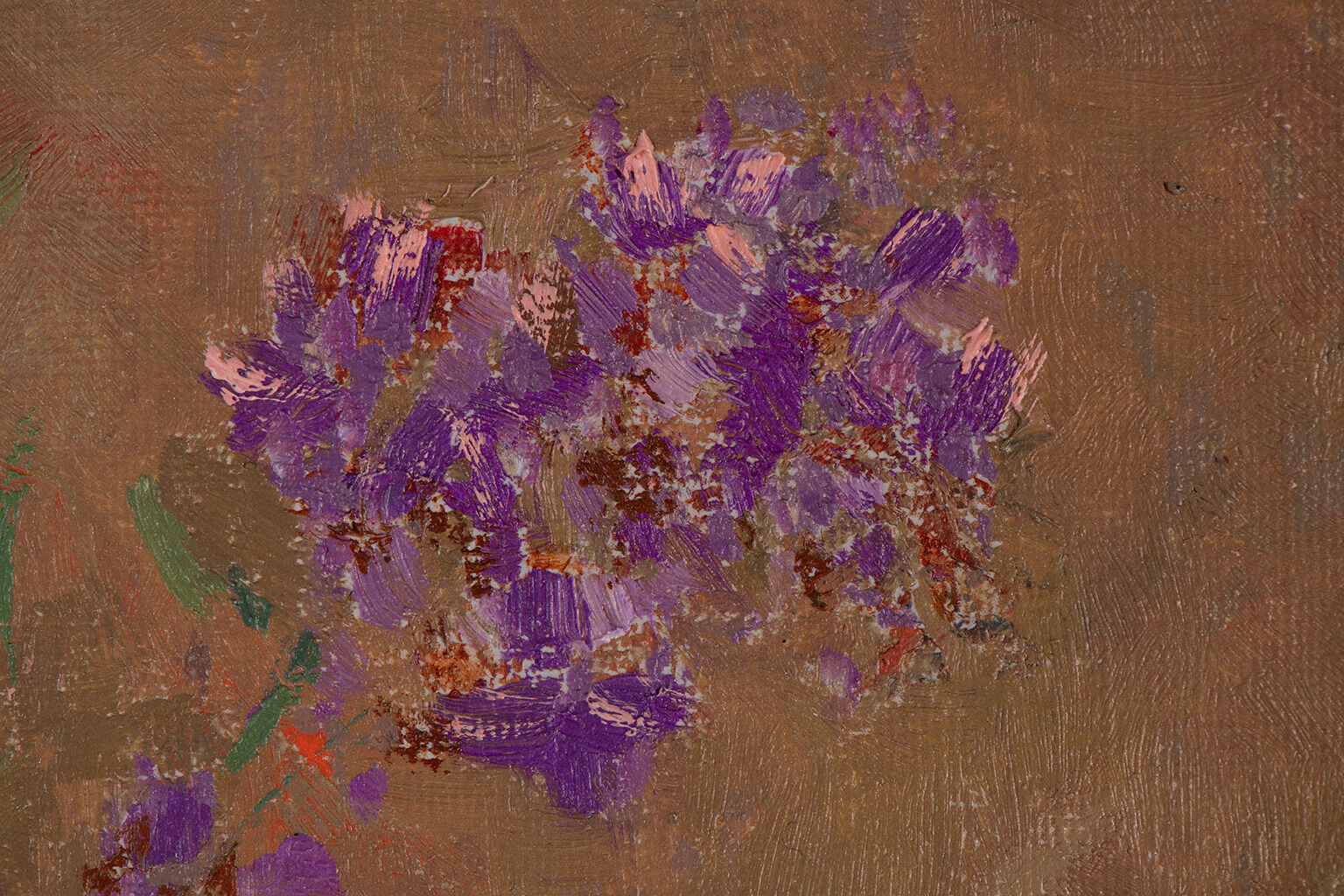 Fig. 10. Detail of underpainting within the right-side purple flowers, The Green Vase (ca. 1900)
Fig. 10. Detail of underpainting within the right-side purple flowers, The Green Vase (ca. 1900)
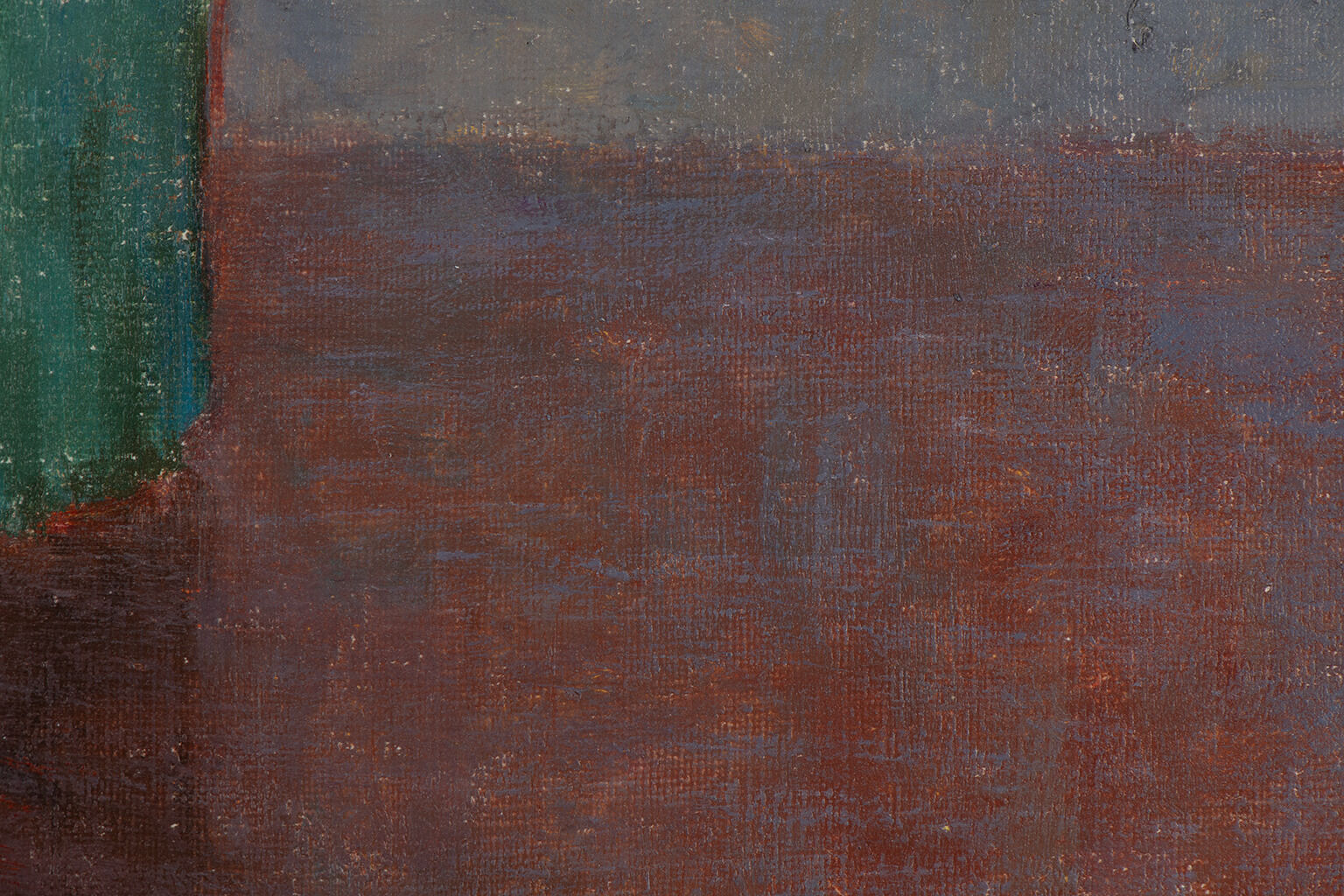 Fig. 11. Detail of the pale blue, dry brushwork over the tabletop, The Green Vase (ca. 1900)
Fig. 11. Detail of the pale blue, dry brushwork over the tabletop, The Green Vase (ca. 1900)
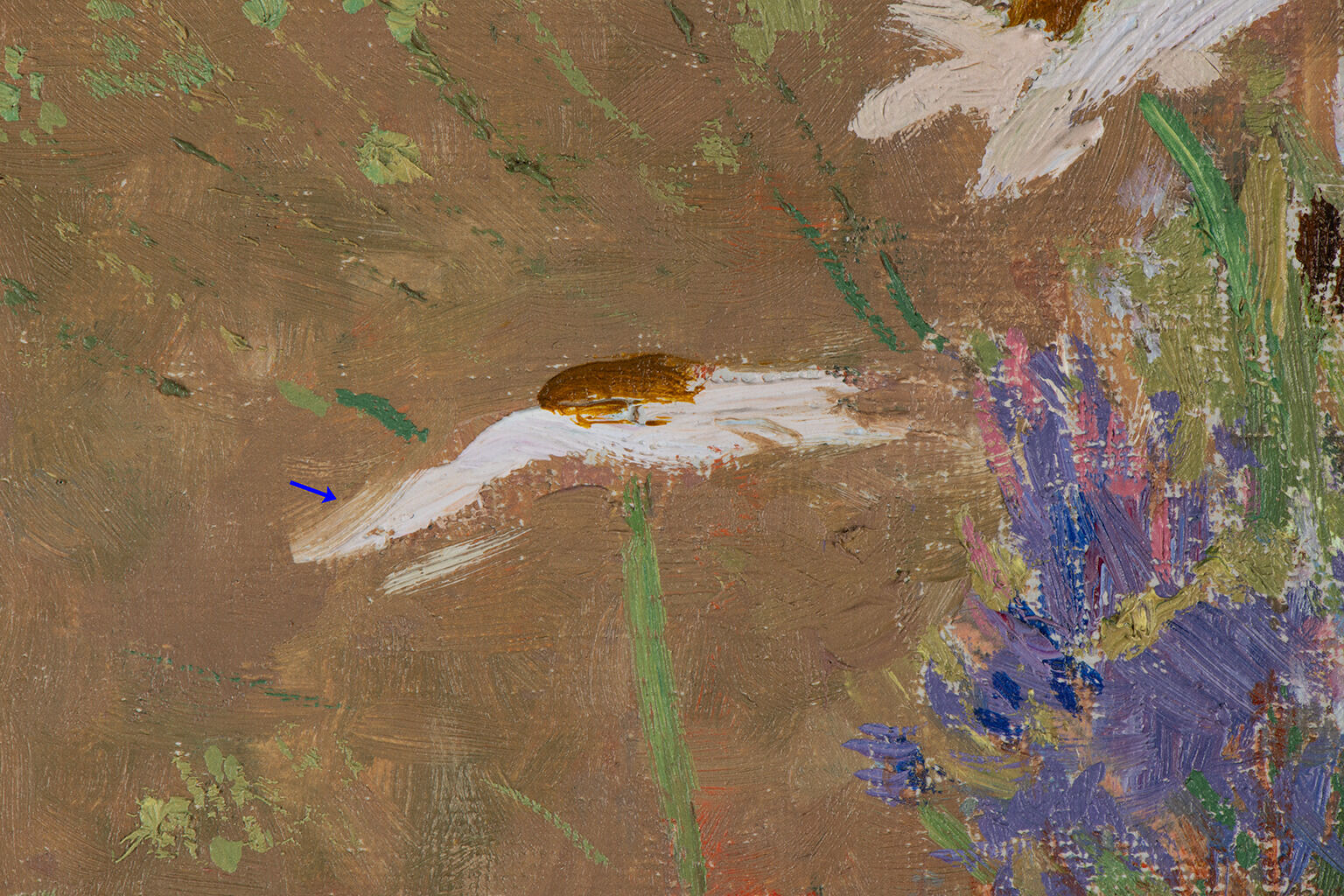 Fig. 12. Detail of wet-over-wet paint application around flower perimeter (blue arrow), The Green Vase (ca. 1900)
Fig. 12. Detail of wet-over-wet paint application around flower perimeter (blue arrow), The Green Vase (ca. 1900)
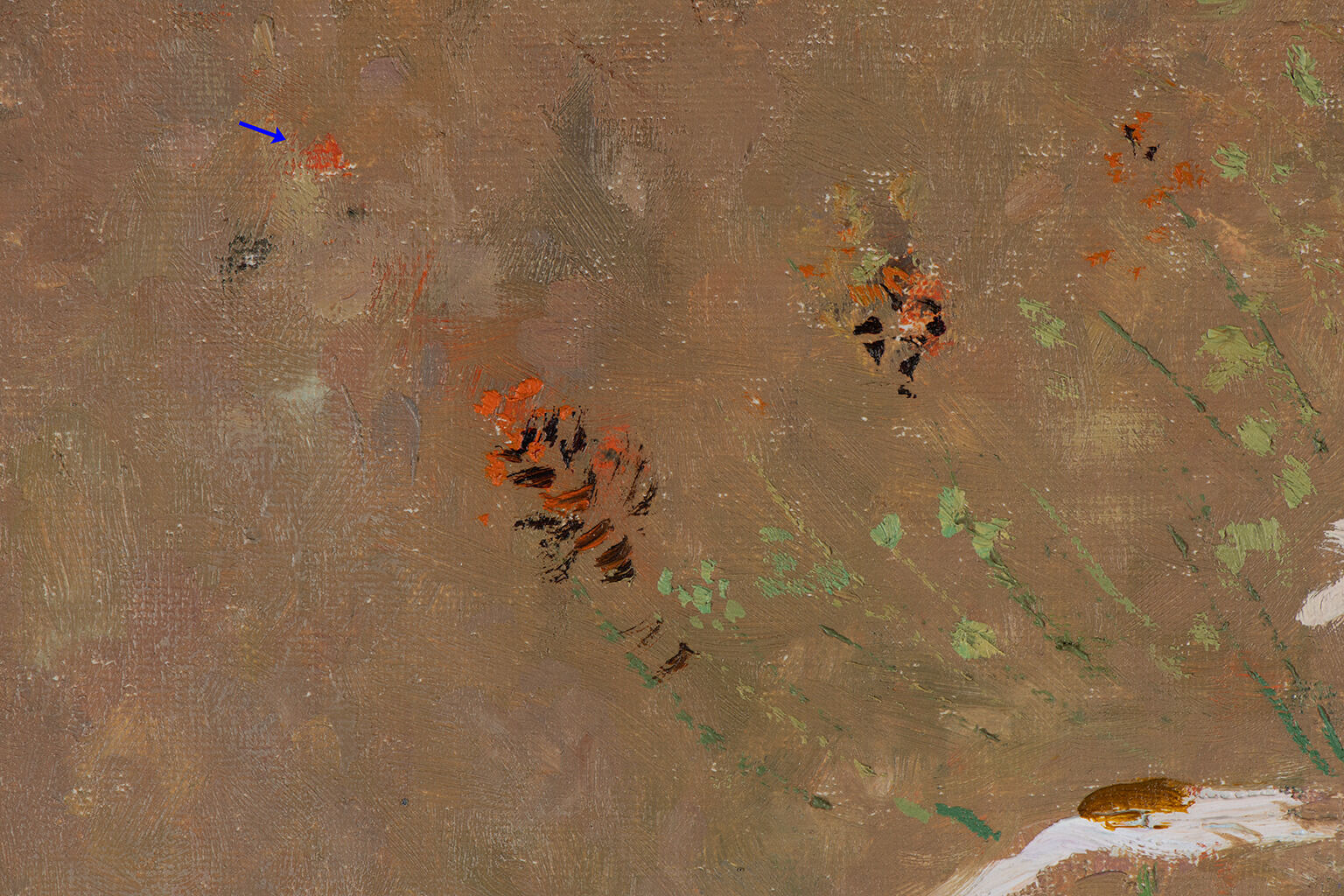
Notes
-
The stretcher is non-original, and a second set of visible tack holes on the stretcher indicates that it was previously used.
-
In its current state, the painting is close in size to a no. 20 paysage standard-format canvas (73 x 56.7 centimeters), rotated ninety degrees. The vertical dimension has retained its original size of 73 centimeters, consistent with all no. 20 standard-formats.
-
The portrait format is the widest of the standard-formats, and therefore the original picture plane was likely not greatly cropped. David Bomford, Jo Kirby, John Leighton, and Ashok Roy, Art in the Making: Impressionism (London: Yale University Press, 1991), 45.
-
Although the stretcher crossbar does have a stamp for the supplier Durand, because this stretcher is not original to The Green Vase, it is unlikely that this stamp relates to this painting.
-
While Redon frequently primed his canvases himself for his symbolist paintings, his flower still lifes were commonly painted on commercially prepared canvases. René Boitelle, Klaas Jan van den Berg, and Eva Goetz, “A Technical Examination of Odilon Redon’s Paintings from the Bonger Collection, Van Gogh Museum,” ArtMatters: Netherlands Technical Studies in Art 3, ed. Erma Hermens (2005): 71.
-
The ground layer is visible along the top, bottom, and left tacking margins, where the original tacking margins remain extant.
-
Boitelle, van den Berg, and Goetz, “A Technical Examination of Odilon Redon’s Paintings from the Bonger Collection, Van Gogh Museum,” 71.
Documentation
Citation
Chicago:
Brigid M. Boyle, “Odilon Redon, The Green Vase, ca. 1900,” documentation in French Paintings and Pastels, 1600–1945: The Collections of The Nelson-Atkins Museum of Art, ed. Aimee Marcereau DeGalan (Kansas City: The Nelson-Atkins Museum of Art, 2022), https://doi.org/10.37764/78973.5.720.4033.
MLA:
Boyle, Brigid M. “Odilon Redon, The Green Vase, ca. 1900,” documentation. French Paintings and Pastels, 1600–1945: The Collections of The Nelson-Atkins Museum of Art, edited by Aimee Marcereau DeGalan, Nelson-Atkins Museum of Art, 2022. doi: 10.37764/78973.5.720.4033.
Provenance
Citation
Chicago:
Brigid M. Boyle, “Odilon Redon, The Green Vase, ca. 1900,” documentation in French Paintings and Pastels, 1600–1945: The Collections of The Nelson-Atkins Museum of Art, ed. Aimee Marcereau DeGalan (Kansas City: The Nelson-Atkins Museum of Art, 2022), https://doi.org/10.37764/78973.5.720.4033.
MLA:
Boyle, Brigid M. “Odilon Redon, The Green Vase, ca. 1900,” documentation. French Paintings and Pastels, 1600–1945: The Collections of The Nelson-Atkins Museum of Art, edited by Aimee Marcereau DeGalan, Nelson-Atkins Museum of Art, 2022. doi: 10.37764/78973.5.720.4033.
Monsieur de Pompidor, near Montpellier, probably by March 12, 1903 [1];
By descent to his daughter, near Montpellier [2];
Inherited by an anonymous private collector, near Montpellier and near Lausanne, by 1993 [3];
Purchased from the latter through Julian Barran Ltd, Bath, England, by Thomas Gibson Fine Art Ltd., London, November 3, 1993–July 18, 1995 [4];
Purchased from Thomas Gibson Fine Art Ltd. by Marion (née Helzberg, 1931–2013) and Henry (1922–2019) Bloch, Shawnee Mission, KS, July 18, 1995–June 15, 2015;
Their gift to The Nelson-Atkins Museum of Art, Kansas City, MO, 2015.
Notes
[1] A collector identified as “M. Pompidor” lent a painting titled Vase de fleurs to the exhibition Pastels et peintures d’Odilon Redon, Galeries Durand-Ruel, Paris, March 12–26, 1903, no. 14. The loaned work was likely The Green Vase; see email from Sophie Pietri, Wildenstein-Plattner Institute, to Brigid M. Boyle, NAMA, January 13, 2021, NAMA curatorial files. Little is known about Monsieur de Pompidor, but he is thought to have solicited advice from French painter Gustave Fayet (1865–1925) when building his collection; see email from Aphrodite O’Sullivan, Thomas Gibson Fine Art Ltd, to Nicole Myers, NAMA, April 27, 2015, NAMA curatorial files.
M. Pompidor may have been Dr. Louis-Paul-Léon-Michel Pompidor (1862–1956), who collected paintings by Vincent van Gogh and other avant-garde artists in the early 1900s. He resided in Narbonne, France, sixty miles from Montpellier. We thank Kirsten Marples for her provenance research on this constituent.
Prior to the 1903 Durand-Ruel exhibition, Redon deposited The Green Vase with Durand-Ruel, Paris, from July 18 to November 30, 1900. He may have placed it there on consignment, although the precise nature of their arrangement is unclear from Durand-Ruel’s extant records. The work never entered Durand-Ruel’s stock and was returned to the artist after four months. See emails from Flavie Durand-Ruel, Durand-Ruel et Cie, to Brigid M. Boyle, NAMA, August 29, 2022 and September 6, 2022, NAMA curatorial files. See also the Durand-Ruel verso label which reads: “O. Redon N° 9846 / Fleurs des champs / rss”.
[2] If Dr. Louis-Paul-Léon-Michel Pompidor was indeed the owner of the The Green Vase, his daughter was Marie-Louise-Suzanne Pompidor (1895–1975), also of Narbonne, likely inherited the painting on May 6, 1956. We thank Cécilia Gazel, Direction Archives, Ville de Narbonne, for her assistance with genealogical research.
[3] According to British appraiser and dealer Julian Barran, “the collector inherited the work from the late daughter of de Pompidor and moved with the collection after the Second World War to Switzerland.” This information was relayed secondhand in an email from Aphrodite O’Sullivan, Thomas Gibson Fine Art Ltd, to Nicole Myers, NAMA, April 28, 2015, NAMA curatorial files.
Barran’s account conflicts with the Redon catalogue raisonné, which claims that The Green Vase belonged to an anonymous collector in Sutherland, Scotland, from circa 1920 to 1995; see Alec Wildenstein and Agnès Lacau St. Guily, Odilon Redon: Catalogue raisonné de l’œuvre peint et dessiné, vol. 3, Fleurs et paysages (Paris: Wildenstein Institute, 1996), no. 1440, p. 69. This latter provenance is likely erroneous, however. See emails from Aphrodite O’Sullivan, Thomas Gibson Fine Art Ltd, to Nicole Myers, NAMA, April 27 and 28, 2015; and email from Sophie Pietri, Wildenstein-Plattner Institute, to Brigid M. Boyle, NAMA, January 13, 2021, NAMA curatorial files.
[4] For dates of ownership, see email from Thomas Gibson, Thomas Gibson Fine Art Ltd, to Nicole Myers, NAMA, April 27, 2015, NAMA curatorial files. Barran’s client consigned The Green Vase to him shortly before he facilitated the sale to Gibson; see email from Julian Barran, Julian Barran Ltd, to Brigid M. Boyle, NAMA, February 3, 2021, NAMA curatorial files.
Related Works
Citation
Chicago:
Brigid M. Boyle, “Odilon Redon, The Green Vase, ca. 1900,” documentation in French Paintings and Pastels, 1600–1945: The Collections of The Nelson-Atkins Museum of Art, ed. Aimee Marcereau DeGalan (Kansas City: The Nelson-Atkins Museum of Art, 2022), https://doi.org/10.37764/78973.5.720.4033.
MLA:
Boyle, Brigid M. “Odilon Redon, The Green Vase, ca. 1900,” documentation. French Paintings and Pastels, 1600–1945: The Collections of The Nelson-Atkins Museum of Art, edited by Aimee Marcereau DeGalan, Nelson-Atkins Museum of Art, 2022. doi: 10.37764/78973.5.720.4033.
Odilon Redon, Bouquet of Wildflowers, ca. 1900, oil on canvas, 21 3/4 x 15 in. (55.3 x 38.1 cm), location unknown, cited in Impressionist and Modern Art: Part One, vol. 1 (New York: Sotheby’s, November 5, 2002), 12–13.
Odilon Redon, Bouquet of Flowers, undated, oil on canvas, 21 5/8 x 18 1/8 in. (55 x 46 cm), location unknown, cited in Alec Wildenstein and Agnès Lacau St. Guily, Odilon Redon: Catalogue raisonné de l’œuvre peint et dessiné, vol. 3, Fleurs et paysages (Paris: Wildenstein Institute, 1996), no. 1442, p. 69.
Exhibitions
Citation
Chicago:
Brigid M. Boyle, “Odilon Redon, The Green Vase, ca. 1900,” documentation in French Paintings and Pastels, 1600–1945: The Collections of The Nelson-Atkins Museum of Art, ed. Aimee Marcereau DeGalan (Kansas City: The Nelson-Atkins Museum of Art, 2022), https://doi.org/10.37764/78973.5.720.4033.
MLA:
Boyle, Brigid M. “Odilon Redon, The Green Vase, ca. 1900,” documentation. French Paintings and Pastels, 1600–1945: The Collections of The Nelson-Atkins Museum of Art, edited by Aimee Marcereau DeGalan, Nelson-Atkins Museum of Art, 2022. doi: 10.37764/78973.5.720.4033.
Probably Pastels et peintures d’Odilon Redon, Galeries Durand-Ruel, Paris, March 12–26, 1903, no. 14, as Vase de fleurs.
19th and 20th Century Masters and Selected Old Masters: 1994, Thomas Gibson Fine Art Ltd, London, May–June 1994, as Le Vase Vert.
The International Fine Art Fair, Booth 26 (Thomas Gibson Fine Art Ltd), New York, May 12–16, 1995.
Manet to Matisse: Impressionist Masters from the Marion and Henry Bloch Collection, The Nelson-Atkins Museum of Art, Kansas City, MO, June 9–September 9, 2007, no. 27, as The Green Vase (Le vase vert).
References
Citation
Chicago:
Brigid M. Boyle, “Odilon Redon, The Green Vase, ca. 1900,” documentation in French Paintings and Pastels, 1600–1945: The Collections of The Nelson-Atkins Museum of Art, ed. Aimee Marcereau DeGalan (Kansas City: The Nelson-Atkins Museum of Art, 2022), https://doi.org/10.37764/78973.5.720.4033.
MLA:
Boyle, Brigid M. “Odilon Redon, The Green Vase, ca. 1900,” documentation. French Paintings and Pastels, 1600–1945: The Collections of The Nelson-Atkins Museum of Art, edited by Aimee Marcereau DeGalan, Nelson-Atkins Museum of Art, 2022. doi: 10.37764/78973.5.720.4033.
Probably Pastels et peintures d’Odilon Redon, exh. cat. (Paris: Galeries Durand-Ruel, 1903), as Vase de fleurs.
Probably Donald E. Gordon, Modern Art Exhibitions, 1900–1916: Selected Catalogue Documentation (Munich: Prestel-Verlag, 1974), 2:64, as Vase de fleurs.
19th and 20th Century Masters and Selected Old Masters: 1994, exh. cat. (London: Thomas Gibson Fine Art, 1994), 16–17, (repro.), as Le Vase Vert.
The International Fine Art Fair: Paintings, Drawings, Sculpture, Renaissance through Impressionism, exh. cat. (London: Thomas Gibson Fine Art, 1995), as Le Vase Vert.
Alec Wildenstein and Agnès Lacau St. Guily, Odilon Redon: Catalogue raisonné de l’œuvre peint et dessiné, vol. 3, Fleurs et paysages (Paris: Wildenstein Institute, 1996), no. 1440, pp. 7, 68–69, 333, 412, (repro.), as Le Vase Vert and Vase de fleurs.
Probably Alec Wildenstein and Marie-Christine Decroocq, Odilon Redon: Catalogue raisonné de l’œuvre peint et dessiné, vol. 4, Études et grandes décorations; Supplément (Paris: Wildenstein Institute, 1998), 333, as Vase de fleurs.
Rebecca Dimling Cochran and Bobbie Leigh, “100 Top Collectors who have made a difference,” Art and Antiques 28, no. 3 (March 2006): 90.
Bobbie Leigh, “Magnificent Obsession,” Art and Antiques 28, no. 6 (June 2006): 61.
Alice Thorson, “A Tiny Renoir Began Impressive Obsession,” Kansas City Star 127, no. 269 (June 3, 2007): E5, as The Green Vase.
“Lasting Impressions: A Tribute to Marion and Henry Bloch,” Member Magazine (The Nelson-Atkins Museum of Art) (Fall 2007): 11–12.
Steve Paul, “Pretty Pictures: Marion and Henry Bloch’s collection of superb Impressionist masters,” Panache 4, no. 3 (Fall 2007): 20.
Richard R. Brettell and Joachim Pissarro, Manet to Matisse: Impressionist Masters from the Marion and Henry Bloch Collection, exh. cat. (Kansas City, MO: Nelson-Atkins Museum of Art, 2007), 11, 138–41, 162, (repro.), as The Green Vase (Le vase vert).
Alice Thorson, “Blochs add to Nelson treasures,” Kansas City Star 130, no. 141 (February 5, 2010): A1.
Carol Vogel, “O! Say, You Can Bid on a Johns,” New York Times 159, no. 54,942 (February 5, 2010): C26.
Thomas M. Bloch, Many Happy Returns: The Story of Henry Bloch, America’s Tax Man (Hoboken: John Wiley and Sons, 2011), 174–75.
Diane Stafford, “Bloch Gift to Go for Nelson Upgrade,” Kansas City Star 135, no. 203 (April 8, 2015): A8.
“Nelson-Atkins Museum of Art officially accessions Bloch Impressionist masterpieces,” Artdaily.org (July 25, 2015): http://artdaily.com/news/80246/Nelson-Atkins-Museum-of-Art-officially-accessions-Bloch-Impressionist-masterpieces.
Julie Paulais, “Le Nelson-Atkins Museum of Art reçoit des tableaux impressionnistes en échange de leurs répliques,” Le Journal des arts (July 30, 2015): https://www.lejournaldesarts.fr/patrimoine/le-nelson-atkins-museum-art-recoit-des-tableaux-impressionnistes-en-echange-de-leurs.
Josh Niland, “The Nelson-Atkins Museum of Art Acquires a Renowned Collection of Impressionist and Postimpressionist Art,” architecturaldigest.com (July 31, 2015): https://www.architecturaldigest.com/story/nelson-atkins-museum-accessions-bloch-art-collection.
Nancy Staab, “Van Gogh is a Go!” 435: Kansas City’s Magazine (September 2015): 76.
“Nelson-Atkins to unveil renovated Bloch Galleries of European Art in winter 2017,” Artdaily.org (July 20, 2016): http://artdaily.com/news/88852/Nelson-Atkins-to-unveil-renovated-Bloch-Galleries-of-European-Art-in-winter-2017-.
“Nelson-Atkins Museum of Art celebrates generosity of Henry Bloch with new acquisition,” Artdaily.org (October 18, 2016): https://artdaily.cc/news/90923/Nelson-Atkins-Museum-of-Art-celebrates-generosity-of-Henry-Bloch-with-new-acquisition#.XnKATqhKiUk.
Catherine Futter et al., Bloch Galleries: Highlights from the Collection of the Nelson-Atkins Museum of Art (Kansas City, MO: Nelson-Atkins Museum of Art, 2016), 113, (repro.), as The Green Vase.
Kelly Crow, “Museum Rewards Donor with Fake Art to Hang at Home,” Wall Street Journal (January 25, 2017): https://www.wsj.com/articles/museum-rewards-donor-with-fake-art-to-hang-at-home-1485370768.
David Frese, “Bloch savors paintings in redone galleries,” Kansas City Star 137, no. 161 (February 25, 2017): 1A.
Albert Hecht, “Henry Bloch’s Masterpieces Collection to Go On Display at Nelson-Atkins Museum,” Jewish Business News (February 26, 2017): http://jewishbusinessnews.com/2017/02/26/henry-bloch-masterpieces-collection/.
David Frese, “Inside the Bloch Galleries: An interactive experience,” Kansas City Star 137, no. 169 (March 5, 2017): 4D, (repro.), as The Green Vase.
“Editorial: Thank you, Henry and Marion Bloch,” Kansas City Star (March 7, 2017), http://www.kansascity.com/opinion/editorials/ article137040948.html [repr., in “Thank you, Henry and Marion Bloch,” Kansas City Star 137, no. 172 (March 8, 2017): 16A].
Hampton Stevens, “(Not Actually) 12 Things To Do During The Big 12 Tournament,” Flatland: KCPT’s Digital Magazine (March 9, 2017): http://www.flatlandkc.org/arts-culture/sports/not-actually-12-big-12-tournament/.
Laura Spencer, “The Nelson-Atkins’ Bloch Galleries Feature Old Masterworks and New Technology,” KCUR (March 10, 2017): http://kcur.org/post/nelson-atkins-bloch-galleries-feature-old-masterworks-and-new-technology#stream/0.
Victoria Stapley-Brown, “Nelson-Atkins Museum’s new European art galleries come with a ‘love story,’” Art Newspaper (March 10, 2017): http://theartnewspaper.com/news/museums/nelson-atkins-museum-s-new-european-art-galleries-come-with-a-love-story/.
Harry Bellet, “Don du ciel pour le Musée Nelson-Atkins,” Le Monde (March 13, 2017): http://www.lemonde.fr/arts/article/2017/03/13/don-du-ciel-pour-le-musee-nelson-atkins_5093543_1655012.html.
Menachem Wecker, “Jewish Philanthropist Establishes Kansas City as Cultural Mecca,” Forward (March 14, 2017): http://forward.com/culture/365264/jewish-philanthropist-establishes-kansas-city-as-cultural-mecca/ [repr., in Menachem Wecker, “Kansas City Collection Is A Chip Off the Old Bloch,” Forward (March 17, 2017): 20–22].
Juliet Helmke, “The Bloch Collection Takes up Residence in Kansas City’s Nelson Atkins Museum,” Blouin ArtInfo International (March 15, 2017): http://www.blouinartinfo.com/news/story/2005267/the-bloch-collection-takes-up-residence-in-kansas-citys.
Louise Nicholson, “How Kansas City got its magnificent museum,” Apollo: The International Art Magazine (April 7, 2017): https://www.apollo-magazine.com/how-kansas-city-got-its-magnificent-museum/.
Lilly Wei, “Julián Zugazagoitia: ‘Museums should generate interest and open a door that leads to further learning,’” Studio International (August 21, 2017): http://studiointernational.com/index.php/julian-zugazagoitia-director-nelson-atkins-museum-of-art-kansas-city-interview, (repro.), as The Green Vase.
Robert D. Hershey Jr., “Henry Bloch, H&R Block’s cofounder, dies at 96,” Boston Globe (April 23, 2019): https://www3.bostonglobe.com/metro/obituaries/ 2019/04/23/henry-bloch-block-cofounder/?arc404=true.
Robert D. Hershey Jr., “Henry W. Bloch, Tax-Preparation Pioneer (and Pitchman), Is Dead at 96,” New York Times (April 23, 2019): https://www.nytimes.com/2019/04/23/obituaries/henry-w-bloch-dead.html.
Megan McDonough, “Henry Bloch, whose H&R Block became world’s largest tax-services provider, dies at 96,” Washington Post (April 23, 2019): https://www.washingtonpost.com/local/obituaries/henry-bloch-whose-handr-block-became-worlds-largest-tax-services-provider-dies-at-96/2019/04/23/19e95a90-65f8-11e9-a1b6-b29b90efa879_story.html.
Claire Selvin, “Henry Wollman Bloch, Collector and Prominent Benefactor of Nelson-Atkins Museum of Art, Is Dead at 96,” ArtNews (April 23, 2019): http://www.artnews.com/2019/04/23/henry-bloch-dead-96/.
Eric Adler and Joyce Smith, “Henry Bloch, co-founder of H&R Block, dies at 96,” Kansas City Star 139, no. 219 (April 24, 2019): 1A.
“Henry Wollman Bloch (1922–2019),” Artforum (April 24, 2019): https://www.artforum.com/news/henry-wollman-bloch-1922-2019-79547.
Frank Morris, “Henry Bloch, Co-Founder Of H&R Block, Dies At 96,” NPR (April 24, 2019): https://www.npr.org/2019/04/24/716641448/henry-bloch-co-founder-of-h-r-block-dies-at-96.
Ignacio Villarreal, “Nelson-Atkins mourns loss of Henry Bloch,” ArtDaily.org (April 24, 2019): http://artdaily.com/news/113035/Nelson-Atkins-mourns-loss-of-Henry-Bloch#.XMB76qR7laQ.
Eric Adler and Joyce Smith, “H&R Block co-founder, philanthropist Bloch dies,” Cass County Democrat Missourian 140, no. 29 (April 26, 2019): 1A.
Eric Adler and Joyce Smith, “KC businessman and philanthropist Henry Bloch dies,” Lee’s Summit Journal 132, no. 79 (April 26, 2019): 1A.
Luke Nozicka, “Family and friends remember Henry Bloch of H&R Block,” Kansas City Star 139, no. 225 (April 30, 2019): 4A [repr., in Luke Nozicka, “Family and friends remember Henry Bloch of H&R Block,” Kansas City Star 139, no. 228 (May 3, 2019): 3A].
Eric Adler, “Sold for $3.25 million, Bloch’s home in Mission Hills may be torn down,” Kansas City Star 141, no. 90 (December 16, 2020): 2A.